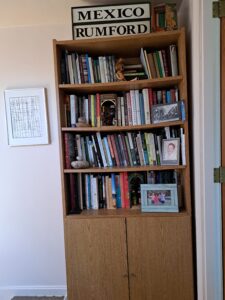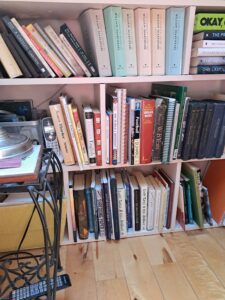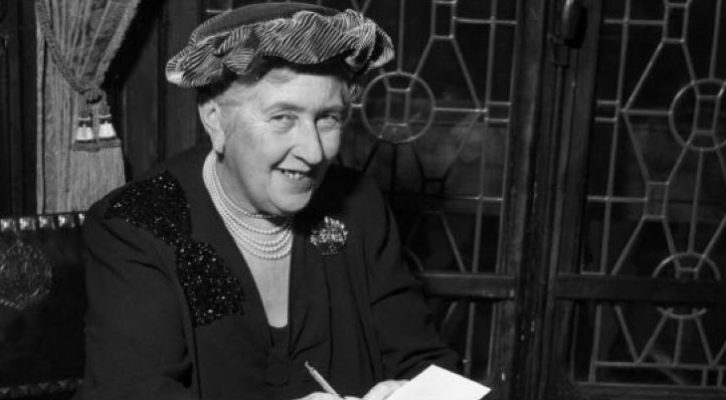
Bookshelves for Your Book Selves: Monica Wood on Why She Organizes Books by Emotion
The Author of “How to Read a Book” Shares Style Advice for Bibliophiles' Bookcases
Though tightly bound by our love of books, we bibliophiles are a sundry lot, managing our obsession in a grand variety of ways. We organize by title, by author, by genre, by topic. By color, by height, by width, by depth. We shelve horizontally, vertically, face out, or in combination. With knick-knacks or without.
We affix bookstore-style section tags to an already orderly trove, or load books into a metaphorical cannon and blast them into every possible cranny, including the microwave. We stack books into attractive still lifes accompanied by a single tulip in a bud vase, or into risky, undulant towers poised to flatten a passing housecat.
I organize books like everything else in my life: by emotion. I did not recognize this system as a system until the day I decided to cull the herd once and for all. Most book lovers come to the Great Purge sooner or later, usually later, when they’re one book shy of divorce or eviction or suffocation or a call from the production team at Hoarders.
Until that moment came for me, I identified as one of the cannon-blasters in a tee shirt reading I Give Up. In my defense, I live in a one-and-a-half story bungalow with two closets, so books take over faster than they might in a roomier abode. In place of high, clean walls begging for high, clean bookcases, my house harbors knee walls and sloped ceilings and only one stick of furniture that could properly be called a bookcase.
My purge began with the books I loved in college, all of them cubbied beneath a low, slanted skylight. These are books I haven’t opened in decades—Jansen’s History of Art; slim volumes of forgotten poetry by John Berryman, Robinson Jeffers, Denise Levertov; stories by Tolstoy and Chekov; plays by Ibsen and O’Neill—and yet the sight of their dusty spines left me so helpless with nostalgia that removing even one felt like breaking up a family.
I organize books like everything else in my life: by emotion.
These books don’t merely spark joy, they’re a fireworks unto themselves, for my girl self abides with them, the nineteen-year-old in a peasant blouse trying out her own writer’s voice. That untouched section of my collection had always felt warm to me—an actual, physical warmth—and suddenly I knew why.
Leaving those titles unharmed, I moved to the shelf I visit first when asked to loan or recommend something. The order makes no sense: two kids’ books—Frog and Toad Together by Arnold Lobel and Quentin Fentin Herter III by Amy MacDonald—flank a miscellany of fiction and nonfiction, including The Family Fang by Kevin Wilson; Coyote v. Acme by Iain Frazier; Raise High the Roofbeam, Carpenters by J.D. Salinger; and Dryer’s English.
I plucked the kid stuff from the stash, thinking they belonged in the books-and-toys bin next to the tv, but the shelf felt instantly off-kilter. I scanned the other titles: The Uncommon Reader by Alan Bennett; Shrinklits by Maurice Sagoff; James Thurber: 92 Stories; and a DIY science-project book called How to Build a Hovercraft. Every one of these books had made me laugh out loud.

Near the top of the proper bookcase, guarded by my Tressy doll from 1964, I found my priest uncle’s leatherbound prayer books with fountain-penned annotations; three copies of English Bulletin containing essays on teaching by my oldest sister; and my mother’s girlhood hardback of Anne of Green Gables, a communion only I would understand, for these volumes make me feel loved.
Nearby, in a soldierly line, the eccentric harmony of The Well-Dressed Ape: A field Guide to Myself by Hannah Holmes; Cargill Falls, stories by William Lychack; two copies of J.B, a play by Archibald MacLeish; and Les Contes du Chat Perché, all of which, for different reasons, force me to read slow.

Who needs the alphabet when a beating heart will do? Why use section titles when the sections name themselves? As I browsed the remaining hollows, I discovered the full brilliance of my “system”: brainy books up here, snow-day books down there, revered books—Remains of the Day, Franny and Zooey, Anything Is Possible—at eye level, a daily gut check from writers far better than I.
Doom-and-gloom books make me queasy (climate/elections/Supreme Court/Big Pharma), and what do you know, I’d placed them in my periphery, in a neat, disposable stack on an unused dresser in a useless alcove.
These choices were inadvertent, which is not the same as accidental. Some inchoate impulse on my part drove each book to the right spot, its rightness visible long after the fact. In only one case did I deliberately marry two volumes, when I tucked one of my own books next to Middlemarch—an outrageous presumption—because I worship George Eliot, believe her to be my spiritual great-grandmother, and hope that by placing our books side by side some of her brilliance will literally rub off on me.

If you believe, as I once did, that your shameful hodgepodge contains no logic, that your mishmash results from desperation and/or sloth, you might take a second, more forgiving look. What the heck is Marshall McLuhan doing between Margaret Atwood and Alice Munro? Soft spot for Canadians, eh? Why did Waiting for Godot wind up beside Atlas Shrugged? Feeling a tad dystopian, are we?
Did The Art of Maine in Winter, Football for Dummies, The Complete Sherlock Holmes and The Collected Poems of W.B. Yeats land together because they’re tall, or because they took you someplace else the year your partner got sick?
Once you start looking, you’ll find feelings made manifest: Books That Make Me Glad to Be Literate; Books That Aren’t Travel Books But Give Me the Wanderlust; Books That Make Me Cry in a Good Way; Weirdo Books I’d Buy Again After Donating them to Goodwill; Books That Got Me Through Covid; Classic Books I Treasure; Classic Books I Want People to Think I Treasure.
Once you start looking, you’ll find feelings made manifest: Books That Make Me Glad to Be Literate; Books That Aren’t Travel Books But Give Me the Wanderlust; Books That Make Me Cry in a Good Way; Weirdo Books I’d Buy Again After Donating them to Goodwill; Books That Got Me Through Covid; Classic Books I Treasure; Classic Books I Want People to Think I Treasure. These private section titles are as unique and unpredictable as the person placing the books.
In the end, I went through every volume in my house and except for the stack of doom books, I purged nothing. I reshelved nothing. The bags I held at the ready remained empty, and every threatened nook escaped unharried. I have a system now. And I feel freshly, exquisitely organized.
______________________________

How to Read a Book by Monica Wood is available via Mariner.
Monica Wood
Monica Wood is the author of When We Were the Kennedys and several novels, including The One-in-a-Million Boy, which was translated into 21 languages in 30 countries. Her writing has appeared in O, The Oprah Magazine, the New York Times, and many other publications. She lives in Portland, Maine.



















